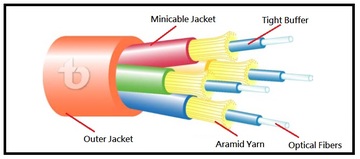-
Loose Tube Type 鬆式型光纖纜線 Self-Supporting Type 自持型光纖纜線 Tight Buffer (Break-out) Type 緊式型光纖纜線 Special Standarder Type 特殊安規型光纖纜線 FTTH 光到府型光纖纜線 回上一頁 -
產品搜尋
首頁 > 宜大-光纖專區(Optical Fibers)> 玻璃光纖Glass Fiber > Tight Buffer (Break-out) Type 緊式型光纖纜線

TLD-SD-F


進口Teldor SD系列室內用緊式光纖纜線
APPLICATIONS
• Short-distance, indoor and protected environments
• Breakout design permitting routing to different locations and direct termination of fibers in the field
• As riser, plenum or general purpose applications
• For multi-fiber pre-terminated cable assemblies
CABLE DESCRIPTION
The cable contains 2 to 36 fibers which are individually buffered to 0.9 mm in a tight or semi-tight construction. Each fiber is individually protected in a minicable consisting of aramid yarn stranded around the fiber, and a PVC or halogen-free flame-retardant sheath. The minicable outer diameter can be 2.8 mm, 2.5 mm or 1.9 mm (standard).
The color-coded minicables are stranded around a central strength member that can be either FRP or flexible alldielectric, and protected with a PVC or a halogen-free, flame-retardant jacket. Fillers are used, as needed, to preserve the cable geometry. The steel armored option is available in conjunction with polyethylene or HFFR jacket. A ripcord is located under the jacket to facilitate jacket removal.
BENEFITS
• Rugged construction
• Easy termination, rugged cable-connector interface
• Individual color-coded minicables allow fast and convenient routing
• Can be installed in air-handling spaces and plenums due to its fire retardant and all-dielectric construction
• Available as OFNR (UL listed Riser rated)
MECHANICAL PROPERTIES
Typical properties are given in the Mechanical Properties Table. Actual properties depend on the cable construction.
OPTICAL PROPERTIES
See the Optical Properties Table.
MATERIALS
See information about the materials used in the Teldor Fiberoptic Cables.
STANDARDS
• Cables tested according to TIA/EIA-455 and IEC-60794-1-2. For details see Test Methods Table.
• Cables meet or exceed Telcordia (Bellcore) requirements for outside plant cables (GR-20) when the appropriate options are chosen
• Cables ordered with HFFR jackets meet IEC-60332-1 standard.
• On request cables meeting the IEC-60332-3 UL 1666 (Riser rating) can be supplied.
MARKING
Cables are marked as follows
Teldor - Fiberoptic Cable - Cable Code - RoHS - Length in Meters
or per customer request.
CABLE DIMENSIONS AND WEIGHTS
See list of most frequently ordered cables next page.
ORDERING
You can find the desired cable in the cable list next page or compose your own cable from the Cable Code Definition
and Selection Guide. Standard cable lengths vary with cable diameter. Other constructions, color codes and materials may be available.
Please contact the Teldor Marketing Department.
Typical Mechanical PropertiesMax. Pulling Load 1500 N or the equivalent of the cable weight per km, whichever is higher Max. Operating Load 60% of the Max. Pulling Load Max. Compressive Load 3000 N for unarmored, 5000 N for armored Repeated Impact 2.9 N.m (J) 3 x 2 impacts Minimum Bending Radius for Installation 20 times the cable O.D. Minimum Long Term Bending Radius 20 times the cable O.D. for armored cables, 10 times the cable O.D. for unarmored cables Twist (Torsion) — Length 180°x10 times , 125 times the cable O.D. Cyclic Flexing 25 cycles for armored cables 300 cycles for unarmored cables Operating Temperature Range -10°C to +50°C Storage Temperature Range -20°C to +70°C
線材剖面
下單資訊
keywords: google, gmail, line, Breakout, Fiberoptic Cable, 室內, 緊式, 光纖纜線, IEC-60332-3, UL1666, gr-20, yeida, 宜大電線,2024/5/16 上午 08:00:06
- YEIDA宜大電線有限公司
- 宜大(YEIDA) 為美國 BELDEN and ALPHA 公司 代理商 (經銷商)
- E-mail: yeida.lin@msa.hinet.net
- E-mail : yeida@ms79.hinet.net
- TEL:(02)2995-4668(代表號) FAX:(02)2278-1798
- 地址:新北市三重區重新路五段639之1號9F
網站所採用資料及圖檔皆屬各公司所有, 本公司決無侵權之意,如有造成不便,請聯絡本公司










